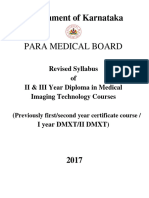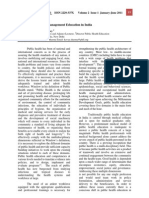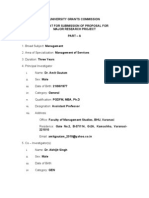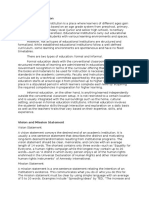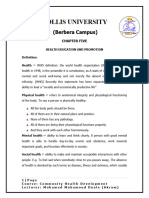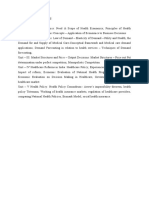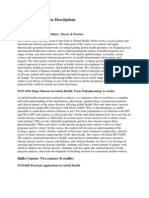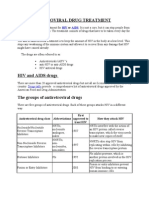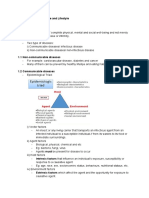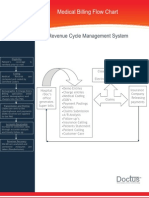Medicine: Clinical Practice
Medicine: Clinical Practice
Uploaded by
Ganesh KaleCopyright:
Available Formats
Medicine: Clinical Practice
Medicine: Clinical Practice
Uploaded by
Ganesh KaleOriginal Description:
Original Title
Copyright
Available Formats
Share this document
Did you find this document useful?
Is this content inappropriate?
Copyright:
Available Formats
Medicine: Clinical Practice
Medicine: Clinical Practice
Uploaded by
Ganesh KaleCopyright:
Available Formats
Medicine
Medicine ( i/mdsn/, i/mdsn/) is the field of applied science related to the art of healing [1] by diagnosis, treatment, and prevention of disease. It encompasses a variety ofhealth care practices evolved to maintain and restore health by the prevention and treatmentof illness in human beings. Contemporary medicine applies health science, biomedical research, genetics and medical technology to diagnose, treat, and prevent injury and disease, typically through medication orsurgery, but also through therapies as diverse as psychotherapy, external splints & [2] traction,prostheses, biologics, pharmaceutials, ionizing radiation among others. The word medicine is derived from the Latin ars medicina, meaning the art of healing.
[3][
Clinical practice
In clinical practice, doctors personally assess patients in order to diagnose, treat, and prevent disease using clinical judgment. The doctor-patient relationship typically begins an interaction with an examination [5] of the patient's medical history and medical record, followed by a medical interview and a physical examination. Basic diagnostic medical devices (e.g. stethoscope, tongue depressor) are typically used. After examination forsigns and interviewing for symptoms, the doctor may order medical tests (e.g. blood tests), take a biopsy, or prescribe pharmaceutical drugs or other therapies. Differential diagnosis methods help to rule out conditions based on the information provided. During the encounter, properly informing the patient of all relevant facts is an important part of the relationship and the development of trust. The medical encounter is then documented in the medical record, which is a legal document in many [6] jurisdictions. Follow-ups may be shorter but follow the same general procedure. The components of the medical interview
[5]
and encounter are:
Chief complaint (CC): the reason for the current medical visit. These are the 'symptoms.' They are in the patient's own words and are recorded along with the duration of each one. Also called 'presenting complaint.' History of present illness / complaint (HPI): the chronological order of events of symptoms and further clarification of each symptom. Current activity: occupation, hobbies, what the patient actually does. Medications (Rx): what drugs the patient takes including prescribed, over-the-counter, and home remedies, as well as alternative and herbal medicines/herbal remedies. Allergies are also recorded. Past medical history (PMH/PMHx): concurrent medical problems, past hospitalizations and operations, injuries, past infectious diseases and/or vaccinations, history of known allergies. Social history (SH): birthplace, residences, marital history, social and economic status, habits (including diet, medications,tobacco, alcohol). Family history (FH): listing of diseases in the family that may impact the patient. A family tree is sometimes used. Review of systems (ROS) or systems inquiry: a set of additional questions to ask, which may be missed on HPI: a general enquiry (have you noticed any weight loss, change in sleep quality, fevers, lumps and bumps? etc.), followed by questions on the body's main organ systems (heart, lungs, digestive tract, urinary tract, etc.).
The physical examination is the examination of the patient for signs of disease ('Symptoms' are what the patient volunteers, 'Signs' are what the healthcare provider detects by examination). The healthcare provider uses the senses of sight, hearing, touch, and sometimes smell (e.g., in infection, uremia, diabetic ketoacidosis). Taste has been made redundant by the availability of modern lab tests. Four actions are taught as the basis of physical examination: inspection, palpation (feel), percussion (tap to determine
resonance characteristics), and auscultation (listen). This order may be modified depending on the main focus of the examination (e.g., a joint may be examined by simply "look, feel, move". Having this set order is an educational tool that encourages practitioners to be systematic in their approach and refrain from using tools such as the stethoscope before they have fully evaluated the other modalities).
Institutions
Contemporary medicine is in general conducted within health care systems. Legal,credentialing and financing frameworks are established by individual governments, augmented on occasion by international organizations, such as churches. The characteristics of any given health care system have significant impact on the way medical care is provided.
Education in India
Education in India is provided by the public sector as well as the private sector, with control and funding coming from three levels: central, state, andlocal. Takshasila was the earliest recorded centre of higher learning in India from at least 5th century BCE and it is debatable whether it could be regarded a university or not. The Nalanda University was the oldest university-system of education in the world in the [3] modern sense of university. Western education became ingrained into Indian society with the establishment of the British Raj. Education in India falls under the control of both the Union Government and the State Governments, with some responsibilities lying with the Union and the states having autonomy for others. The various articles of the Indian Constitution provide for education as a fundamental right. Most universities in India are controlled by the Union or the State Governments. India has made progress in terms of increasing the primary educationattendance rate and [4] expanding literacy to approximately three quarters of the population. India's improved education system [5] is often cited as one of the main contributors to the economic rise of India. Much of the progress, especially in higher education and scientific research, has been credited to various public institutions. The [citation needed] private education market in India was 5% and in terms of value was estimated to be worth [6] US$40 billion in 2008 but had increased to US$6870 billion by 2012. As per the Annual Status of Education Report (ASER) 2012, 96.5% of all rural children between the ages of 6-14 were enrolled in school. This is the fourth annual survey to report enrollment above 96%. 83% of all rural 15-16 year olds were enrolled in school. However, going forward, India will need to focus more on quality. Gross enrollment at the tertiary level has crossed 20% (as per an Ernst & Young Report cited in Jan 2013 in Education News/minglebox.com) As per the latest (2013) report issued by the All India Council of Technical Education (AICTE), there are more than 3524 diploma and post-diploma offering institutions in the country with an annual intake capacity of over 1.2 million. The AICTE also reported 3495 degree-granting engineering colleges in India with an annual student intake capacity of over 1.76 million with actual enrollment crossing 1.2 million.. Capacity for Management Education crossed 385000, and post graduate degree slots in Computer Science crossed 100,000. Pharmacy slots reached over 121,000. Total annual intake capacity for technical diplomas and degrees exceeded 3.4 million in 2012. According to the University Grants Commission (UGC) total enrollment in Science, Medicine, Agriculture and Engineering crossed 6.5 million in 2010.
Charu Sudan Kasturi reported in the Hindustan Times (New Delhi, 10 January 2011) that the number of women choosing engineering has more than doubled since 2001. In the India education system, a significant number of seats are reserved under affirmative action policies for the historically disadvantaged Scheduled Castes and Scheduled Tribes and Other Backward Classes. In universities/colleges/institutions affiliated to the federal government there is a minimum 50% of reservations applicable to these disadvantaged groups, at the state level it can vary. Andhra Pradesh had 83.33% reservation in 2012, which is the highest percentage of reservations in India.
History
Brahmin gurus historically offered education by means of donations, rather than charging fees or the procurement of funds from students or their guardians. Later, temples also became centres of education; religious education was compulsory, but secular subjects were also taught. Students were required to be brahmacharis or celibates. The knowledge in these orders was often related to the tasks a section of the society had to perform. The priest class, the Brahmins, were imparted knowledge of religion, philosophy, and other ancillary branches while the warrior class, the Kshatriya, were trained in the various aspects of warfare. The business class, the Vaishya, were taught their trade and the working class of the Shudras was generally deprived of educational advantages. The book of laws, the Manusmriti, and the treatise on statecraft the Arthashastra were among the influential works of this era which reflect the outlook and understanding of the world at the time.
Overview
India's education system is divided into different levels such as pre-primary level, primary level, [7] elementary education, secondary education, undergraduate level and postgraduate level. The National Council of Educational Research and Training(NCERT) is the apex body for curriculum related matters for [8] school education in India. The NCERT provides support and technical assistance to a number of [9] schools in India and oversees many aspects of enforcement of education policies. In India, the various curriculum bodies governing school education system are: The state government boards, in which the majority of Indian children are enrolled. The Central Board of Secondary Education (CBSE). CBSE conducts two examinations, namely, the All India Secondary School Examination, AISSE (Class/Grade 10) and the All India Senior School Certificate Examination, AISSCE (Class/Grade 12).
10+2+3 pattern[
The central and most state boards uniformly follows the "10+2+3" pattern of education. In this pattern, [12]:44 [13] or in colleges), and then 3 years of college education for bachelor's degree. The 10 years is further divided into 5 years of primary education and 3 years of upper primary, followed by 2 years of high [12]:5 [14] school. This pattern originated from the recommendation the Education Commission of 1964 66.
[12]:3
Primary education system in India
The Indian government lays emphasis on primary education up to the age of fourteen years, referred to [15] as elementary education in India. The Indian government has also banned child labour in order to [15] ensure that the children do not enter unsafe working conditions. However, both free education and the [15] ban on child labour are difficult to enforce due to economic disparity and social conditions. 80% of all recognized schools at the elementary stage are government run or supported, making it the largest [16] provider of education in the country.
You might also like
- Health Care Delivery SystemDocument42 pagesHealth Care Delivery SystemAnusha Verghese96% (23)
- Questionnaire For Self-Medication: If NO, Please Go To Part B Question 1Document10 pagesQuestionnaire For Self-Medication: If NO, Please Go To Part B Question 1sunny bhalla100% (2)
- Determinant of HealthDocument8 pagesDeterminant of Healthlisa.prihastari100% (1)
- Guideline For Implimentation of SRA Schemes PDFDocument187 pagesGuideline For Implimentation of SRA Schemes PDFGanesh KaleNo ratings yet
- Sri Lanka AllDocument28 pagesSri Lanka AllsuntharthiNo ratings yet
- Health Care Delivery SystemDocument45 pagesHealth Care Delivery SystemamritanshuNo ratings yet
- Assignment in Concepts of Health and DiseasesDocument9 pagesAssignment in Concepts of Health and Diseasessyxia279No ratings yet
- HealthCareSectorinindia AnOverviewDocument23 pagesHealthCareSectorinindia AnOverviewAnitha NoronhaNo ratings yet
- Public HealthDocument13 pagesPublic HealthGlorious GullyNo ratings yet
- DOT-syllabus 220130 163901Document19 pagesDOT-syllabus 220130 163901Angkasa LamaNo ratings yet
- 4.2 Background of The StudyDocument10 pages4.2 Background of The StudyriddhiNo ratings yet
- Components of The National Health SystemDocument7 pagesComponents of The National Health SystemNop PiromNo ratings yet
- Government of Karnataka: para Medical BoardDocument32 pagesGovernment of Karnataka: para Medical BoardAdarsh JhaNo ratings yet
- Health Care Delivery System in IndiaDocument65 pagesHealth Care Delivery System in IndiaAparna Kingini100% (1)
- IEC NotesDocument21 pagesIEC Notessandraanja70No ratings yet
- 1.1 How Healthcare Policy Is Translated Into Practice.: 1.2 The Organisations Involved in Healthcare On National andDocument5 pages1.1 How Healthcare Policy Is Translated Into Practice.: 1.2 The Organisations Involved in Healthcare On National andTuray Abdullah FNo ratings yet
- Healthcare Management 2 ND PartDocument24 pagesHealthcare Management 2 ND Partfathi.saadNo ratings yet
- Upazila Ngos: Public Health Has Been Defined As "The Science and Art of Preventing Disease, Prolonging LifeDocument14 pagesUpazila Ngos: Public Health Has Been Defined As "The Science and Art of Preventing Disease, Prolonging Lifehasibul khalidNo ratings yet
- Reviewv 2 I 1Document4 pagesReviewv 2 I 1Asim MahatoNo ratings yet
- UGC Project FormatDocument19 pagesUGC Project FormatAmit GautamNo ratings yet
- Introduction To Health ResearchDocument22 pagesIntroduction To Health Researchdoreen100% (1)
- Assessing The Landscape of Healthcare in India-1Document13 pagesAssessing The Landscape of Healthcare in India-1sumit kumarNo ratings yet
- His HalfDocument22 pagesHis HalfMae Ann BusicoNo ratings yet
- Information Education and Communication 1Document17 pagesInformation Education and Communication 1jbd365No ratings yet
- Ijsra 2023 0141Document7 pagesIjsra 2023 0141frpss frpssNo ratings yet
- From A Pathologist's DeskDocument33 pagesFrom A Pathologist's DeskDr Suvarna NalapatNo ratings yet
- Economics of Social Sector ED 315 Module 1Document31 pagesEconomics of Social Sector ED 315 Module 1bhavyajha784No ratings yet
- Muthoot PRJCTDocument78 pagesMuthoot PRJCTAlex ValiyaveettilNo ratings yet
- Pdhpe HSC SyllabusDocument30 pagesPdhpe HSC Syllabusbwallace1997No ratings yet
- Hierarchical Planning Models For Public Healthcare Services - ProposalDocument11 pagesHierarchical Planning Models For Public Healthcare Services - ProposalhassanyarbareachNo ratings yet
- PH D Course ProposalDocument8 pagesPH D Course ProposalSujitNo ratings yet
- Health Care Delivery System in IndiaDocument11 pagesHealth Care Delivery System in IndiaAnish VeettiyankalNo ratings yet
- Thesis Healthcare ManagementDocument7 pagesThesis Healthcare Managementlesliedanielstallahassee100% (2)
- Quality AssesmentDocument54 pagesQuality AssesmentadithyanvsNo ratings yet
- HEALTH CARE MODELSDocument12 pagesHEALTH CARE MODELSkeerthubts13No ratings yet
- DES 312 Health in DevelopmentDocument188 pagesDES 312 Health in DevelopmentPastor-Oshatoba Femi JedidiahNo ratings yet
- Health is the birth right of every individualDocument46 pagesHealth is the birth right of every individualthamizhselvi87No ratings yet
- Health LiteracyDocument12 pagesHealth LiteracyTengiz VerulavaNo ratings yet
- Community 4Document5 pagesCommunity 4merin sunilNo ratings yet
- HIS-Learning Feedback Diary 3Document2 pagesHIS-Learning Feedback Diary 3mio mahilig sa hugsNo ratings yet
- Infrastructure For Health PromotionDocument3 pagesInfrastructure For Health PromotionLuo MiyandaNo ratings yet
- Chapter 2: What Is Primary Health Care (PHC) and Why?Document3 pagesChapter 2: What Is Primary Health Care (PHC) and Why?alphabennydelta4468No ratings yet
- Awareness On Healthcare And Hygeine Of Standard VIII StudentsDocument6 pagesAwareness On Healthcare And Hygeine Of Standard VIII StudentsM. KanmaniNo ratings yet
- Cph Lec PowerpointDocument16 pagesCph Lec Powerpointfamilara2315887No ratings yet
- Medicine and Law-IntroductionDocument21 pagesMedicine and Law-Introductionpritish.panda222No ratings yet
- Chapter 5 6 7Document9 pagesChapter 5 6 7maxamed maxamuudNo ratings yet
- Chapter 1Document26 pagesChapter 1David Raju GollapudiNo ratings yet
- Gha Course DescriptionsDocument8 pagesGha Course DescriptionsGlobal Health AffairsNo ratings yet
- Ijerph 13 00975Document16 pagesIjerph 13 00975suryo samsonNo ratings yet
- Ch3 + Ch4 ModifyDocument38 pagesCh3 + Ch4 ModifyomaralthbetiNo ratings yet
- Medical EthicsDocument11 pagesMedical EthicsEmmanuel MwishoNo ratings yet
- Factors Influencing Health Knowledge and Behaviors Among The Elderly in Rural ChinaDocument17 pagesFactors Influencing Health Knowledge and Behaviors Among The Elderly in Rural ChinaDilaArdaNiNo ratings yet
- Health Education Overview 2022-2023Document39 pagesHealth Education Overview 2022-2023Ivan MoralesNo ratings yet
- Teaching PE and Health Lesson 2Document18 pagesTeaching PE and Health Lesson 2Gelo Delos SantosNo ratings yet
- Chapter - 1 Nature, Scope, Objectives and Methodology of ResearchDocument18 pagesChapter - 1 Nature, Scope, Objectives and Methodology of ResearchJobin BabuNo ratings yet
- Chapter - 1 Nature, Scope, Objectives and Methodology of ResearchDocument18 pagesChapter - 1 Nature, Scope, Objectives and Methodology of ResearchJobin BabuNo ratings yet
- Chapter - 1 Nature, Scope, Objectives and Methodology of ResearchDocument18 pagesChapter - 1 Nature, Scope, Objectives and Methodology of ResearchJobin BabuNo ratings yet
- Chapter - 1 Nature, Scope, Objectives and Methodology of ResearchDocument18 pagesChapter - 1 Nature, Scope, Objectives and Methodology of ResearchJobin BabuNo ratings yet
- Chapter - 1 Nature, Scope, Objectives and Methodology of ResearchDocument18 pagesChapter - 1 Nature, Scope, Objectives and Methodology of ResearchMohammad MudasirNo ratings yet
- Kingshuk Patra - Social and Preventive Pharmacy - KINGSHUK PATRADocument10 pagesKingshuk Patra - Social and Preventive Pharmacy - KINGSHUK PATRAPayel MukherjeeNo ratings yet
- Health Education CurriculumDocument3 pagesHealth Education Curriculumbamidele.ifNo ratings yet
- Bombay Stock ExchangeDocument10 pagesBombay Stock ExchangeGanesh KaleNo ratings yet
- As You Sow, So Shall You Reap (TIT FOR TAT) Full StoryDocument1 pageAs You Sow, So Shall You Reap (TIT FOR TAT) Full StoryGanesh KaleNo ratings yet
- Pickaxe: American English Hand Tool PerpendicularDocument1 pagePickaxe: American English Hand Tool PerpendicularGanesh KaleNo ratings yet
- Anhingasouth American CapybaraDocument1 pageAnhingasouth American CapybaraGanesh KaleNo ratings yet
- Under The Guidance ofDocument6 pagesUnder The Guidance ofGanesh KaleNo ratings yet
- 36 Weblist of M.com - Part I Yearly 16.10.2015Document30 pages36 Weblist of M.com - Part I Yearly 16.10.2015Ganesh KaleNo ratings yet
- Career ProjectDocument51 pagesCareer ProjectGanesh KaleNo ratings yet
- Objectives: Acquisition & Disposal of LandDocument5 pagesObjectives: Acquisition & Disposal of LandGanesh KaleNo ratings yet
- Research Institute VisitDocument6 pagesResearch Institute VisitGanesh KaleNo ratings yet
- Environmental Information CentreDocument7 pagesEnvironmental Information CentreGanesh KaleNo ratings yet
- Diverticular Disease and Intestinal ObstructionDocument31 pagesDiverticular Disease and Intestinal ObstructionPauLa Cheneree Peña ÜNo ratings yet
- Clinical Manifestations of Children With COVID 19: A Systematic ReviewDocument9 pagesClinical Manifestations of Children With COVID 19: A Systematic ReviewImin BuntaraNo ratings yet
- 5th Whirlpool and hubbard tanksDocument20 pages5th Whirlpool and hubbard tanksahmedsalah7378No ratings yet
- What Is HIV Antiretroviral Drug TreatmentDocument24 pagesWhat Is HIV Antiretroviral Drug TreatmentDhrishya PadmakumarNo ratings yet
- Nikita CV24Document5 pagesNikita CV24bhaveenshethNo ratings yet
- Wjoa 2 66Document2 pagesWjoa 2 66Aarathi raoNo ratings yet
- DNA VaccineDocument19 pagesDNA VaccineMahesh Yadav100% (1)
- Cardiorenal Syndrome: Definition, Prevalence, Diagnosis, and PathophysiologyDocument14 pagesCardiorenal Syndrome: Definition, Prevalence, Diagnosis, and PathophysiologyOlga BabiiNo ratings yet
- Presentation, Analysis and Interpretation of DataDocument3 pagesPresentation, Analysis and Interpretation of DataJacquelyn CarpioNo ratings yet
- Data Quality Monitoring Surveillance System Evaluation Sept 2014Document100 pagesData Quality Monitoring Surveillance System Evaluation Sept 2014eucileneNo ratings yet
- Better Communication With Children and ParentsDocument5 pagesBetter Communication With Children and ParentsNicolás TurianoNo ratings yet
- How To Case TakingDocument11 pagesHow To Case TakingElenaMatsnevaNo ratings yet
- EMEA - Summary of The Product CharacteristicsDocument20 pagesEMEA - Summary of The Product CharacteristicskadecNo ratings yet
- Route of Drug AdministrationDocument14 pagesRoute of Drug AdministrationGangaram Saini100% (1)
- LEC8 OncologyDocument19 pagesLEC8 Oncologymian gNo ratings yet
- National Health PoliciesDocument8 pagesNational Health Policiesajnesh100% (1)
- KMCT College of Nursing: Master Rotation Plan For Second Year BSC Nursing 2012-13Document4 pagesKMCT College of Nursing: Master Rotation Plan For Second Year BSC Nursing 2012-13Suraj RajuNo ratings yet
- 10 1016@j JBMT 2020 05 005Document41 pages10 1016@j JBMT 2020 05 005Yara Borini RossiNo ratings yet
- Nursing WorkforceDocument6 pagesNursing WorkforceNashon Reiner KNo ratings yet
- GIM2002: Health, Disease and Lifestyle Chapter 1: Introduction HealthDocument20 pagesGIM2002: Health, Disease and Lifestyle Chapter 1: Introduction HealthFion TayNo ratings yet
- Spectrum of Histomorphological Diagnosis in Cystoscopic Bladder BiopsiesDocument4 pagesSpectrum of Histomorphological Diagnosis in Cystoscopic Bladder BiopsieskushalNo ratings yet
- Eye Donation SlidesDocument23 pagesEye Donation SlidesNaveen MootaNo ratings yet
- Dog Games Hand Out 2015Document2 pagesDog Games Hand Out 2015Madison Sullivan100% (1)
- Perry: Maternal Child Nursing Care, 4 Edition: Chapter 10: Anatomy and Physiology of Pregnancy Test Bank Multiple ChoiceDocument13 pagesPerry: Maternal Child Nursing Care, 4 Edition: Chapter 10: Anatomy and Physiology of Pregnancy Test Bank Multiple ChoiceChristopher Endicott100% (3)
- Position Paper On Stem Cell Therapy 131008Document2 pagesPosition Paper On Stem Cell Therapy 131008Autism Society PhilippinesNo ratings yet
- Flow ChartDocument8 pagesFlow ChartiEuvilleNo ratings yet
- Antimicrobial Drugs: Iwan Dwiprahasto Department of Pharmacology and Therapy Faculty of Medicine GMUDocument61 pagesAntimicrobial Drugs: Iwan Dwiprahasto Department of Pharmacology and Therapy Faculty of Medicine GMUadysti100% (1)
- Small Animal Clinical NutritionDocument8 pagesSmall Animal Clinical NutritionJairo PereiraNo ratings yet
- C E R T I F I C A T E - B' To Be Completed in The Case of Patients Who Are Admitted To Hospital For TreatmentDocument2 pagesC E R T I F I C A T E - B' To Be Completed in The Case of Patients Who Are Admitted To Hospital For Treatmentelmore kakaNo ratings yet












